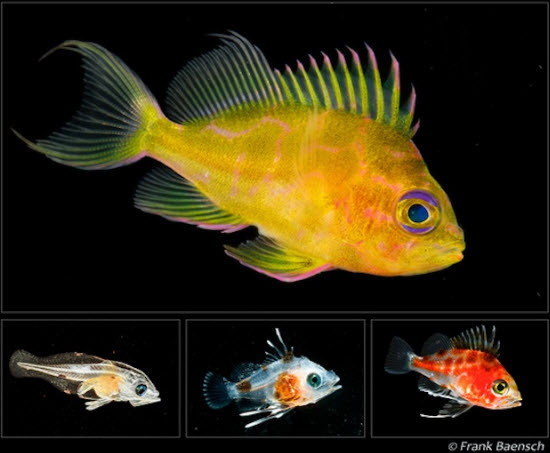
Hawaiian deepwater fish successfully reared from wild collected eggs
Odontanthias fuscipinnis, commonly known as Yellow Fin Anthias, is a much sought after deepwater fish endemic to the waters of Hawaii. It’s highly coveted by reef aquarists due to its striking coloration, and can cost $1 000 or more to procure.
In the future, captive raised Yellow Fin Anthias may start showing up in the trade, because marine fish expert Frank Baensch has now managed to rear wild collected eggs into nearly full grown fish in captivity. As far as we know, he is the first person to ever accomplish this feat. The species was reared as part of the Hawaii Larval Fish Project.
In December 2012, Baensch collected a small number of eggs from surface waters off Oahu and brought them to RCT Hawaii. When the eggs hatched, bright red larvae emerged.
“Features of the larvae include an elongated second dorsal spine and pelvic fin rays; pronounced head spination; brown pigment spots below the dorsal fin; and red pigment blotches on the body,” says the official blog of the Hawaii Larval Fish Project.
The larvae was kept in a 50 liter tank with multiple species and were fed wild caught Copepod nauplii plankton. According to Baensch, the larvae were robust in their 50 liter mixed species environment – good news for other marine aquarists interested in breeding or raising Yellow Fin Anthias.
As they matured over the course of 80 days, the larvae developed into small juvenile fish, lost their bright redness and started displaying the yellow coloration typical for adult Yellow Fin Anthias.
Odontanthias
Odontanthias is a genus of fishes in the subfamily Anthiinae in the family Serranidae. They inhabit rocky reefs and are found in deep waters; typically below 100 meters. A vast majority of the known species live in the Indo-Pacific, but Odontanthias hensleyi is native to the Caribbean
Just like other members of the subfamily Anthiinae, Odontanthias are planktivores with a peaceful temperament. They form schools in the wild and can be seen in large numbers above the reef while feeding. Since they are small to medium-sized, strikingly colored, non-aggressive and do not eat other fish, they have become much sought after by marine fish keepers.